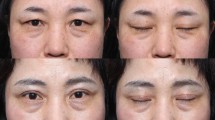Abstract
Background
“Sunken eyelid” is a term used to describe a deeply sunken area between the upper eyelid and upper edge of the orbital bone. The condition frequently is accompanied by blepharoptosis. Correction of a “sunken eyelid” generally is performed with a fat graft. However, surgical limitations such as a movement dysfunction of the upper eyelid or irregular skin surface often are encountered using the grafting method previously reported. An open technique is believed to be more precise than a closed procedure, and satisfactory results may be achieved by repositioning the upper eyelid fat and applying a fat graft to the retro-orbicularis orbital fat (ROOF).
Methods
Fat was harvested from the medial thigh area using a 10-ml syringe with minimal pressure. During the upper eyelid surgery, the orbital fat was relocated between the conjoined tendon of the levator aponeurosis and the lower orbicularis oculi muscle and skin flap. The ROOF was verified, and fat grafting then was performed from the upper medial side to the lower lateral side and from the medial aspect to the lateral direction using an 18-gauge Coleman needle. The sunken eyelids were classified into grades 1 to 4 according to the sunken depth (i.e., the distance between the most inferior orbital rim and the site of the most sunken area). The amount of fat graft and the technique of incorporating the fat were different according to sunken depth.
Results
From January 2006 to June 2008, 50 Korean and Chinese patients (48 women and 2 men) underwent fat repositioning and ROOF fat grafting using an open technique. The patients ranged in age from 24 to 67 years. The mean observation period was 4.7 months. The amount of fat graft for each palpebra was 0.3 to 3.3 ml, and the mean graft amount was 1.4 ml. Satisfactory results were obtained for most of the patients, but four patients required additional surgery. The reasons for the secondary surgery were a translocation of the fat graft to a lower position forming a lump (2 patients) and undercorrection (2 patients). The rate of fat absorption was relatively low and the complications very few compared with surgical cases involving a noninvasive method.
Conclusions
More precise treatment is possible by dividing the depressed area of the upper eyelid according to the stage. Satisfactory results were achieved by relocating the orbital fat using an open method and adjusting the ROOF fat graft according to the stage.










Similar content being viewed by others
References
Camirand A, Doucet J, Harris J (2005) Eyelid aging: the historical evaluation of its management. Aesth Plast Surg 29:65–73
Coleman SR (1997) Facial recontouring with lipostructure. Clin Plast Surg 24:347–367
Kim YK, Lee HG (2000) Correction of the sunken upper eyelid using dermofat graft. J Korean Soc Aesthetic Plast Surg 6:44–49
Frileck SP (2002) The lumbrical fat graft: a replacement for lost upper eyelid fat. Plast Reconstr Surg 109:1696–1705
Lee Y, Kwon S, Hwang K (2001) Correction of sunken and/or multiply folded upper eyelid by fascia-fat graft. Plast Reconstr Surg 107:15–19
Maniglia JJ, Maniglia RF, dos Santos MCJ, Robret F, Maniglia FF, Maniglia SF (2006) Surgical treatment of the sunken upper eyelid. Arch Facial Plast Surg 8:269–272
Shorr N, Christenbury JD, Goldgerg RA (1988) Free autogenous “pearl fat” grafts to the eyelids. Ophthal Plast Reconstr Surg 4:37–40
McFarland JE (1988) The free autogenous fat graft: a comparison of the fat “pearl” and fat “cell” graft in an animal model. Ophthal Plast Reconstr Surg 4:41–47
Stevenson TW (1949) Fat grafts to the face. Plast Reconstr Surg 4:458–468
Coleman SR (2004) Structural fat grafting. Quality Medical Publishing, St. Louis, MO
Amar RE (1999) Microinfiltration adipocyte (MIA) au niveau de la face, ou restruction tissulaire par greffe de tissue adipeux [Adipocyte microinfiltration in the face or tissue restructuration with fat tissue graft]. Ann Chir Plast Esthet 44:593–608
Yoon DY, Kang CU, Bae YC (2008) Correction of sunken upper eyelids using incisional double eyelidplasty and autologous microfat grafting into orbital septum. J Korean Soc Aesthetic Plast Surg 14:139–144
May JW Jr, Fearon J, Zingararelli P (1990) Retro-orbicularis oculi fat (ROOF) resection in aesthetic blepharoplasty: a 6-year study in 63 patients. Plast Reconstr Surg 86:682–689
Ichinose A, Tahara S (2008) Extended preseptal fat resection in Asian blepharoplasty. Ann Plast Surg 60:121–126
Siegel R (1984) Surgical anatomy of the upper eyelid fascia. Ann Plast Surg 13:263–273
Zide BM (2006) Surgical anatomy around the orbit. Lippincott Williams & Wilkins, Philadelphia, PA
Hwang SH, Hwang K, Jin S, Kim DJ (2007) Location and nature of retro-orbicularis oculus fat and suborbicularis oculi fat. J Craniofac Surg 18:387–390
Locke MB, de Chalain TM (2008) Current practice in autologous fat transplantation: suggested clinical guidelines based on a review of recent literature. Ann Plast Surg 60:98–102
Author information
Authors and Affiliations
Corresponding author
Rights and permissions
About this article
Cite this article
Park, S., Kim, B. & Shin, Y. Correction of Superior Sulcus Deformity With Orbital Fat Anatomic Repositioning and Fat Graft Applied to Retro-Orbicularis Oculi Fat for Asian Eyelids. Aesth Plast Surg 35, 162–170 (2011). https://doi.org/10.1007/s00266-010-9574-y
Received:
Accepted:
Published:
Issue Date:
DOI: https://doi.org/10.1007/s00266-010-9574-y




